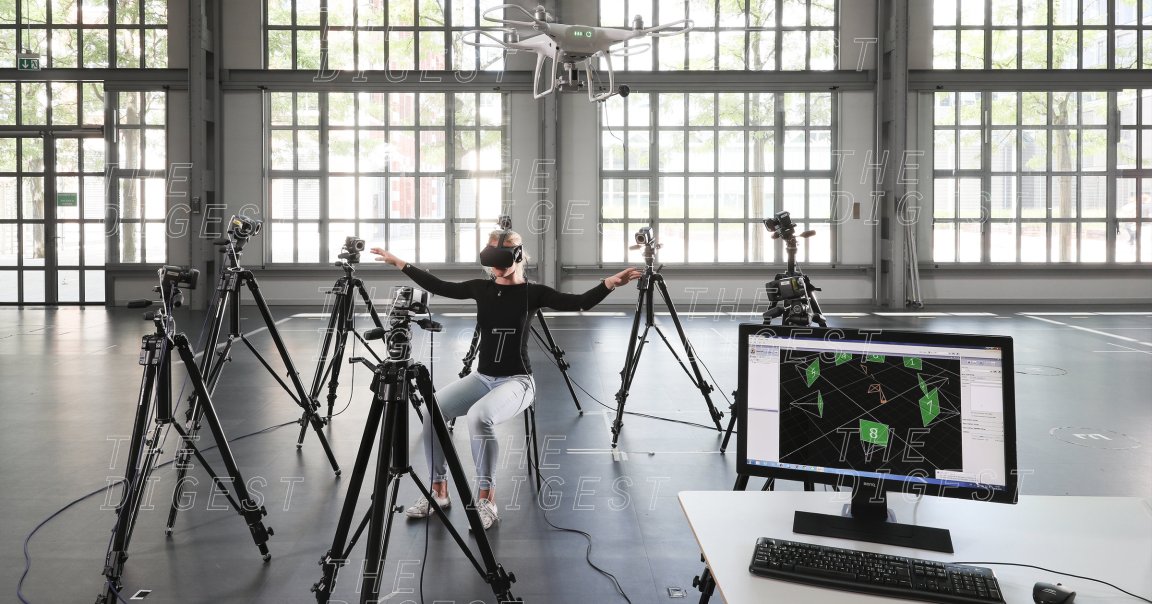
PUT DOWN THE JOYSTICK. If you’ve ever tried to pilot a drone, it’s probably taken a little while to do it well; each drone is a little different, and figuring out how to use its manual controller can take time. There seems to be no shortcut other than to suffer a crash landing or two.
Now, a team of researchers from the Swiss Federal Institute of Technology in Lausanne (EPFL) have created a wearable drone controller that makes the process of navigation so intuitive, it requires almost no thought at all. They published their research in the journal PNAS on Monday.
NOW, PRETEND YOU’RE A DRONE. To create their wearable drone controller, the researchers first needed to figure out how people wanted to move their bodies to control a drone. So they placed 19 motion-capture markers and various electrodes all across the upper bodies of 17 volunteers. Then, they asked each volunteer to watch simulated drone footage through virtual reality goggles. This let the volunteer feel like they were seeing through the eyes of a drone.
The researchers then asked the volunteers to move their bodies however they liked to mimic the drone as it completed five specific movements (for example, turning right or flying toward the ground). The markers and electrodes allowed the researchers to monitor those movements, and they found that most volunteers moved their torsos in a way simple enough to track using just four motion-capture markers.
With this information, the researchers created a wearable drone controller that could relay the user’s movements to an actual drone — essentially, they built a wearable joystick.

PUTTING IT TO THE TEST. To test their wearable drone controller, the researchers asked 39 volunteers to complete a real (not virtual) drone course using either the wearable or a standard joystick. They found that volunteers wearing the suit outperformed those using the joystick in both learning time and steering abilities.
“Using your torso really gives you the feeling that you are actually flying,” lead author Jenifer Miehlbradt said in a press release. “Joysticks, on the other hand, are of simple design but mastering their use to precisely control distant objects can be challenging.”
IN THE FIELD. Mehlbradt envisions search and rescue crews using her team’s wearable drone controller. “These tasks require you to control the drone and analyze the environment simultaneously, so the cognitive load is much higher,” she told Inverse. “I think having control over the drone with your body will allow you to focus more on what’s around you.”
However, this greater sense of immersion in the drone’s environment might not be beneficial in all scenarios. Previous research has shown that piloting strike drones for the military can cause soldiers to experience significant levels of trauma, and a wearable like the EPFL team’s has the potential to exacerbate the problem.
While Miehlbradt told Futurism her team did not consider drone strikes while developing their drone suit, she speculates that such applications wouldn’t be a good fit.
“I think that, in this case, the ‘distance’ created between the operator and the drone by the use of a third-party control device is beneficial regarding posterior emotional trauma,” she said. “With great caution, I would speculate that our control approach — should it be used in such a case — may therefore increase the risk of experiencing such symptoms.”
READ MORE: Drone Researchers Develop Genius Method for Piloting Using Body Movements [Inverse]
More on rescue drones: A Rescue Drone Saved Two Teen Swimmers on Its First Day of Deployment